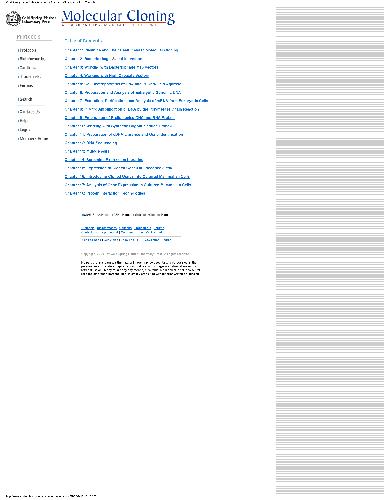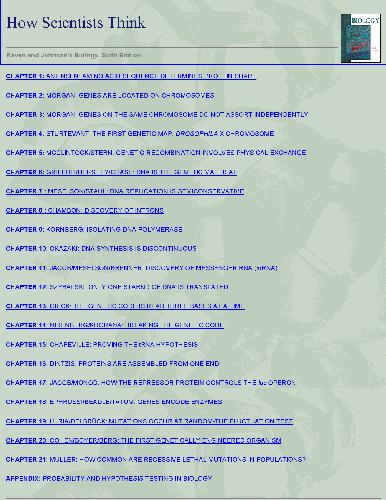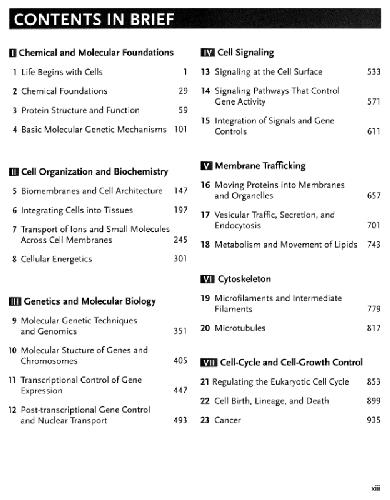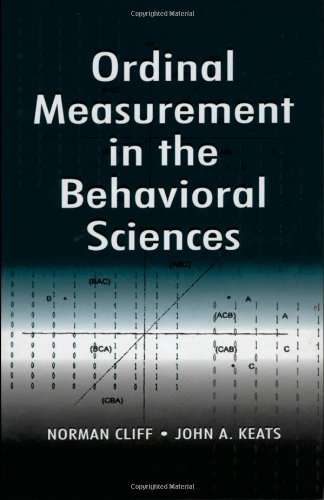Table of contents :
Molecular Cloning……Page 1
1: Plasmids’ Usefulness……Page 2
1 Minipreparation……Page 4
2 Midipreparation……Page 5
3 Maxipreparation……Page 6
4 Small-scale Boiling Lysis……Page 7
5 Large-scale Boiling Lysis……Page 8
6 Toothpick Minipreparation……Page 9
7 Preparation of Plasmid DNA by Lysis with SDS……Page 10
8 Purification of Plasmid DNA by Precipitation with Polyethylene Glycol……Page 12
9 Purification of Plasmid DNA by Chromatography……Page 13
10Purification of Closed Circular DNA by Equilibrium Centrifugation in CsCl-EB Gradients: Continuous Gradients……Page 14
11Purification of Closed Circular DNA by Equilibrium Centrifugation in CsCl-Ethidium Bromide Gradients: Discontinuous Gradients……Page 15
12Removal of Ethidium Bromide from DNA by Extraction with Organic Solvents……Page 16
13Removal of Ethidium Bromide from DNA by Ion-exchange Chromatography……Page 17
14Removal of Small Fragments of Nucleic Acid from Preparations of Plasmid DNA by Centrifugation through NaCl……Page 18
15Removal of Small Fragments of Nucleic Acid from Preparations of Plasmid DNA by Chromatography through Sephacryl S-1000……Page 19
16Removal of Small Fragments of Nucleic Acid from Preparations of Plasmid DNA by Precipitation with Lithium Chloride……Page 20
17Directional Cloning into Plasmid Vectors……Page 21
18Attaching Adaptors to Protruding Termini……Page 22
19Blunt-ended Cloning into Plasmid Vectors……Page 23
20Dephosphorylation of Plasmid DNA……Page 25
21Addition of Synthetic Linkers to Blunt-ended DNA……Page 27
22Ligating Plasmid and Target DNAs in Low-melting-temperature Agarose……Page 28
23The Hanahan Method for Preparation and Transformation of Competent E. coli: High-efficiency Transformation……Page 29
24The Inoue Method for Preparation and Transformation of Competent E. Coli: “Ultra-Competent” Cells……Page 31
25Preparation and Transformation of Competent E. coli Using Calcium Chloride……Page 33
26Transformation of E. coli by Electroporation……Page 34
27Screening Bacterial Colonies Using X-gal and IPTG: α-Complementation……Page 35
28Screening Bacterial Colonies by Hybridization: Small Numbers……Page 36
29Screening Bacterial Colonies by Hybridization: Intermediate Numbers……Page 37
30Screening Bacterial Colonies by Hybridization: Large Numbers……Page 38
31Lysing Colonies and Binding of DNA to Filters……Page 39
32Hybridization of Bacterial DNA on Filters……Page 40
2: Bacteriophage and Its Vectors……Page 41
1 Plating Bacteriophage λ……Page 43
2 Picking Bacteriophage λ Plaques……Page 44
3 Preparing Stocks of Bacteriophage λ by Plate Lysis and Elution……Page 45
4 Preparing Stocks of Bacteriophage λ by Small-scale Liquid Culture……Page 46
5 Large-scale Growth of Bacteriophage λ: Infection at Low Multiplicity……Page 47
6 Precipitation of Bacteriophage λ Particles from Large-scale Lysates……Page 48
7 Assaying the DNA Content of Bacteriophage λ Stocks and Lysates by Gel Electrophoresis……Page 49
8 Purification of Bacteriophage λ Particles by Isopycnic Centrifugation through CsCl Gradients……Page 50
9 Purification of Bacteriophage λ Particles by Centrifugation through a Glycerol Step Gradient……Page 51
10Purification of Bacteriophage λ Particles by Pelleting/Centrifugation……Page 52
11Extraction of Bacteriophage λ DNA from Large-scale Cultures Using Proteinase K and SDS……Page 53
12Extraction of Bacteriophage λ DNA from Large-scale Cultures Using Formamide……Page 54
13Preparation of Bacteriophage λ DNA Cleaved with a Single Restriction Enzyme for Use as a Cloning Vector……Page 55
14Preparation of Bacteriophage λ DNA Cleaved with Two Restriction Enzymes for Use as a Cloning Vector……Page 56
15Alkaline Phosphatase Treatment of Bacteriophage λ Vector DNA……Page 57
16Purification of Bacteriophage λ Arms: Centrifugation through Sucrose Density Gradients……Page 58
17Partial Digestion of Eukaryotic DNA for Use in Genomic Libraries: Pilot Reactions……Page 60
18Partial Digestion of Eukaryotic DNA for Use in Genomic Libraries: Preparative Reactions……Page 61
19Ligation of Bacteriophage λ Arms to Fragments of Foreign Genomic DNA……Page 62
20Amplification of Genomic Libraries……Page 63
21Transfer of Bacteriophage DNA from Plaques to Filters……Page 64
22Hybridization of Bacteriophage DNA on Filters……Page 66
23Rapid Analysis of Bacteriophage λ Isolates: Purification of λ DNA from Plate Lysates……Page 68
24Rapid Analysis of Bacteriophage λ Isolates: Purification of λ DNA from Liquid Cultures……Page 70
3: Working with Bacteriophage M13 Vectors……Page 71
1 Plating Bacteriophage M13……Page 72
2 Growing Bacteriophage M13 in Liquid Culture……Page 73
3 Preparation of Double-stranded (Replicative Form) Bacteriophage M13 DNA……Page 74
4 Preparation of Single-stranded Bacteriophage M13 DNA……Page 75
5 Large-scale Preparation of Single-stranded and Double-stranded Bacteriophage M13 DNA……Page 76
6 Cloning into Bacteriophage M13 Vectors……Page 77
7 Analysis of Recombinant Bacteriophage M13 Clones……Page 79
8 Producing Single-stranded DNA with Phagemid Vectors……Page 80
4: Working with High-Capacity Vectors……Page 81
1 Construction of Genomic DNA Libraries in Cosmid Vectors……Page 82
2 Screening an Unamplified Cosmid Library by Hybridization: Plating the Library onto Filters……Page 84
3 Amplification and Storage of a Cosmid Library: Amplification in Liquid Culture……Page 85
4 Amplification and Storage of a Cosmid Library: Amplification on Filters……Page 86
5 Working with Bacteriophage P1 and Its Cloning Systems……Page 87
6 Transferring Bacteriophage P1 Clones between E. coli Hosts……Page 89
7 Working with Bacterial Artificial Chromosomes……Page 90
8 Isolation of BAC DNA from Small-scale Cultures……Page 91
9 Isolation of BAC DNA from Large-scale Cultures……Page 92
10Working with Yeast Artificial Chromosomes……Page 93
11Growth of S. cerevisiae and Preparation of DNA……Page 94
12Small-scale Preparations of Yeast DNA……Page 95
13Analyzing Yeast Colonies by PCR……Page 96
14Isolating the Ends of Genomic DNA Fragments Cloned in High-capacity Vectors: Vectorette Polymerase Chain Reactions……Page 97
5: Gel Electrophoresis of DNA and Pulsed-Field Agarose……Page 99
1 Agarose Gel Electrophoresis……Page 101
2 Detection of DNA in Agarose Gels……Page 102
3 Recovery of DNA from Agarose Gels: Electrophoresis onto DEAE-cellulose Membranes……Page 103
4 Recovery of DNA from Agarose and Polyacrylamide Gels: Electroelution into Dialysis Bags……Page 105
5 Purification of DNA Recovered from Agarose and Polyacrylamide Gels by Anion-exchange Chromatography……Page 106
6 Recovery of DNA from Low-melting-temperature Agarose Gels: Organic Extraction……Page 107
7 Recovery of DNA from Low-melting-temperature Agarose Gels: Enzymatic Digestion with Agarase……Page 108
8 Alkaline Agarose Gel Electrophoresis……Page 109
9 Neutral Polyacrylamide Gel Electrophoresis……Page 110
10Detection of DNA in Polyacrylamide Gels by Staining……Page 112
11Detection of DNA in Polyacrylamide Gels by Autoradiography……Page 113
12Isolation of DNA Fragments from Polyacrylamide Gels by the Crush and Soak Method……Page 114
13Preparation of DNA for Pulsed-field Gel Electrophoresis: Isolation of DNA from Mammalian Cells and Tissues……Page 116
14Preparation of DNA for Pulsed-field Gel Electrophoresis: Isolation of Intact DNA from Yeast……Page 118
15Restriction Endonuclease Digestion of DNA in Agarose Plugs……Page 119
16Markers for Pulsed-field Gel Electrophoresis……Page 120
17Pulsed-field Gel Electrophoresis via Transverse Alternating Field Electrophoresis Gels……Page 121
18Pulsed-field Gel Electrophoresis via Contour-clamped Homogeneous Electric Field Gels……Page 123
19Direct Retrieval of DNA Fragments from Pulsed-field Gels……Page 124
20Retrieval of DNA Fragments from Pulsed-field Gels following DNA Concentration……Page 125
6: Preparation and Analysis of Eukaryotic Genomic DNA……Page 126
1 Isolation of High-molecular-weight DNA from Mammalian Cells Using Proteinase K and Phenol……Page 127
2 Isolation of High-molecular-weight DNA from Mammalian Cells Using Formamide……Page 129
3 Isolation of DNA from Mammalian Cells by Spooling……Page 130
4 Isolation of DNA from Mammalian Cells Grown in 96-well Microtiter Plates……Page 131
5 Preparation of Genomic DNA from Mouse Tails and Other Small Samples……Page 132
6 Rapid Isolation of Mammalian DNA……Page 134
7 Rapid Isolation of Yeast DNA……Page 135
8 Southern Blotting: Capillary Transfer of DNA to Membranes……Page 136
9 Southern Blotting: Simultaneous Transfer of DNA from a Single Agarose Gel to Two Membranes……Page 138
10Southern Hybridization of Radiolabeled Probes to Nucleic Acids Immobilized on Membranes……Page 139
7:Extraction, Purification, and Analysis of mRNA from Eukaryotic
Cells……Page 141
1 Purification of RNA from Cells and Tissues by Acid Phenol-Guanidinium Thiocyanate-Chloroform Extraction……Page 143
2 A Single-step Method for the Simultaneous Preparation of DNA, RNA, and Protein from Cells and Tissues……Page 145
3 Selection of Poly(A)+ RNA by Oligo(dT)-Cellulose Chromatography……Page 147
4 Selection of Poly(A)+ RNA by Batch Chromatography……Page 148
5 Separation of RNA According to Size: Electrophoresis of Glyoxylated RNA through Agarose Gels……Page 149
6 Separation of RNA According to Size: Electrophoresis of RNA through Agarose Gels Containing Formaldehyde……Page 150
7 Transfer and Fixation of Denatured RNA to Membranes……Page 151
8 Northern Hybridization……Page 153
9 Dot and Slot Hybridization of Purified RNA……Page 154
10Mapping RNA with Nuclease S1……Page 155
11Ribonuclease Protection: Mapping RNA with Ribonuclease and Radiolabeled RNA Probes……Page 157
12Analysis of RNA by Primer Extension……Page 159
8:In Vitro Amplification of DNA by the Polymerase Chain Reaction……Page 161
1 The Basic Polymerase Chain Reaction……Page 163
2 Purification of PCR Products in Preparation for Cloning……Page 164
3 Removal of Oligonucleotides and Excess dNTPs from Amplified DNA by Ultrafiltration……Page 165
4 Blunt-end Cloning of PCR Products……Page 166
5 Cloning PCR Products into T Vectors……Page 167
6 Cloning PCR Products by Addition of Restriction Sites to the Termini of Amplified DNA……Page 168
7 Genetic Engineering with PCR……Page 170
8 Amplification of cDNA Generated by Reverse Transcription of mRNA……Page 172
9 Rapid Amplification of 5′ cDNA Ends (5′-RACE)……Page 174
10Rapid Amplification of 3′cDNA Ends (3′-RACE)……Page 176
11Mixed Oligonucleotide-primed Amplification of cDNA (MOPAC)……Page 178
12Rapid Characterization of DNAs Cloned in Prokaryotic Vectors……Page 180
13Long PCR……Page 181
14Inverse PCR……Page 182
15 Quantitative PCR……Page 184
16 Differential Display-PCR……Page 186
9:Preparation of Radiolabeled DNA and RNA Probes……Page 189
1 Random Priming: Radiolabeling of Purified DNA Fragments by Extension of Random Oligonucleotides……Page 191
2 Random Priming: Radiolabeling of DNA by Extension of Random Oligonucleotides in the Presence of Melted Agarose……Page 192
3 Radiolabeling of DNA Probes by the Polymerase Chain Reaction……Page 193
4 Synthesis of Single-stranded DNA Probes of Defined Length from Bacteriophage M13 Templates……Page 194
5 Synthesis of Single-stranded DNA Probes of Heterogeneous Length from Bacteriophage M13 Templates……Page 196
6 Synthesis of Single-stranded RNA Probes by In Vitro Transcription……Page 197
7 Synthesis of cDNA Probes from mRNA Using Random Oligonucleotide Primers……Page 199
8 Synthesis of Radiolabeled, Subtracted cDNA Probes Using Oligo(dT) as a Primer……Page 201
9 Radiolabeling of Subtracted cDNA Probes by Random Oligonucleotide Extension……Page 203
10Labeling 3′ Termini of Double-stranded DNA Using the Klenow Fragment of E. coli DNA Polymerase I……Page 205
11Labeling 3′ Termini of Double-stranded DNA with Bacteriophage T4 DNA Polymerase……Page 206
12End Labeling Protruding 3′ Termini of Double-stranded DNA with [α-32P]Cordycepin 5′-Triphosphate or [α-32P]dideoxyATP……Page 207
13Dephosphorylation of DNA Fragments with Alkaline Phosphatase……Page 208
14Phosphorylation of DNA Molecules with Protruding 5′-Hydroxyl Termini……Page 210
15Phosphorylation of DNA Molecules with Dephosphorylated Blunt Ends or Recessed 5′ Termini……Page 211
16Phosphorylation of DNA Molecules with Protruding 5′ Termini by the Exchange Reaction……Page 212
10:Working with Synthetic Oligonucleotide Probes……Page 213
1 Purification of Synthetic Oligonucleotides by Polyacrylamide Gel Electrophoresis……Page 215
2 Phosphorylating the 5′ Termini of Oligonucleotides……Page 217
3
Purification of Radiolabeled Oligonucleotides by Precipitation with Ethanol……Page 218
4 Purification of Radiolabeled Oligonucleotides by Precipitation with Cetylpyridinium Bromide……Page 219
5 Purification of Radiolabeled Oligonucleotides by Size-exclusion Chromatography……Page 220
6 Purification of Radiolabeled Oligonucleotides by Chromatography on a Sep-Pak C18 Column……Page 221
7 Labeling of Synthetic Oligonucleotides Using the Klenow Fragment of E. coli DNA Polymerase I……Page 222
8 Hybridization of Oligonucleotide Probes in Aqueous Solutions: Washing in Buffers Containing Quaternary Ammonium Salts……Page 223
9 Empirical Measurement of Melting Temperature……Page 224
11:Preparation of cDNA Libraries and Gene Identification……Page 226
1 Construction of cDNA Libraries
Stage 1: Synthesis of First-strand cDNA Catalyzed by Reverse Transcriptase……Page 228
2 Construction of cDNA Libraries
Stage 2: Second-strand Synthesis……Page 230
3 Construction of cDNA Libraries
Stage 3: Methylation of cDNA……Page 232
4 Construction of cDNA Libraries
Stage 4: Attachment of Linkers or Adaptors……Page 233
5 Construction of cDNA Libraries
Stage 5: Fractionation of cDNA by Gel Filtration through Sepharose CL-4B……Page 235
6 Construction of cDNA Libraries
Stage 6: Ligation of cDNA to Bacteriophage λ Arms……Page 236
7 Construction and Screening of Eukaryotic Expression Libraries
Stage 1: Construction of cDNA Libraries in Eukaryotic Expression Vectors……Page 237
8 Construction and Screening of Eukaryotic Expression Libraries
Stage 2: Screening cDNA Libraries Constructed in Eukaryotic Expression Vectors……Page 238
9 Exon Trapping and Amplification
Stage 1: Construction of the Library……Page 240
10Exon Trapping and Amplification
Stage 2: Electroporation of the Library into COS-7 Cells……Page 242
11Exon Trapping and Amplification
Stage 3: Harvesting the mRNA……Page 243
12Exon Trapping and Amplification
Stage 4: Reverse Transcriptase-PCR……Page 244
13Exon Trapping and Amplification
Stage 5: Analysis of Clones……Page 246
14Direct Selection of cDNAs with Large Genomic DNA Clones……Page 247
12:DNA Sequencing……Page 250
1 Generation of a Library of Randomly Overlapping DNA Inserts……Page 251
2 Preparing Denatured Templates for Sequencing by Dideoxy-mediated Chain Termination……Page 254
3 Dideoxy-mediated Sequencing Reactions Using Bacteriophage T7 DNA Polymerase (Sequenase)……Page 255
4 Dideoxy-mediated Sequencing Reactions Using the Klenow Fragment of E. coli DNA Polymerase I and Single-stranded DNA Templates……Page 257
5 Dideoxy-mediated Sequencing of DNA Using Taq DNA Polymerase……Page 259
6 Cycle Sequencing: Dideoxy-mediated Sequencing Reactions Using PCR and End-labeled Primers……Page 261
7 Chemical Sequencing……Page 263
8 Preparation of Denaturing Polyacrylamide Gels……Page 265
9 Preparation of Denaturing Polyacrylamide Gels Containing Formamide……Page 267
10Preparation of Electrolyte Gradient Gels……Page 268
11Loading and Running DNA-sequencing Gels……Page 269
12Autoradiography and Reading of Sequencing Gels……Page 271
13:Mutagenesis……Page 272
1 Preparation of Uracil-containing Single-stranded Bacteriophage M13 DNA……Page 274
2 Oligonucleotide-directed Mutagenesis of Single-stranded DNA……Page 276
3 In Vitro Mutagenesis Using Double-stranded DNA Templates: Selection of Mutants with DpnI……Page 278
4 Oligonucleotide-directed Mutagenesis by Elimination of a Unique Restriction Site (USE Mutagenesis)……Page 280
5 Rapid and Efficient Site-directed Mutagenesis by the Single-tube Megaprimer PCR Method……Page 282
6 Site-specific Mutagenesis by Overlap Extension……Page 283
7 Screening Recombinant Clones for Site-directed Mutagenesis by Hybridization to Radiolabeled Oligonucleotides……Page 285
8 Detection of Mutations by Single-strand Conformational Polymorphism……Page 287
9 Generation of Sets of Nested Deletion Mutants with Exonuclease III……Page 289
10Generation of Bidirectional Sets of Deletion Mutants by Digestion with BAL 31 Nuclease……Page 291
14:Screening Expression Libraries……Page 293
1 Screening Expression Libraries Constructed in Bacteriophage λ Vectors……Page 294
2 Screening Expression Libraries Constructed in Plasmid Vectors……Page 297
3 Removal of Cross-reactive Antibodies from Antiserum: Pseudoscreening……Page 300
4 Removal of Cross-reactive Antibodies from Antiserum: Incubation with E. coli Lysate……Page 301
5 Removal of Cross-reactive Antibodies from Antiserum: Affinity Chromatography……Page 302
6 Identifying DNA-binding Proteins in Bacteriophage λ Expression Libraries……Page 303
7 Preparation of Lysates Containing Fusion Proteins Encoded by Bacteriophage λ Lysogens: Lysis of Bacterial Colonies……Page 305
8 Preparation of Lysates Containing Fusion Proteins Encoded by Bacteriophage λ: Lytic Infections on Agar Plates……Page 307
9 Preparation of Lysates Containing Fusion Proteins Encoded by Bacteriophage λ: Lytic Infections in Liquid Medium……Page 308
15:Expression of Cloned Genes in Escherichia coli……Page 309
1 Expression of Cloned Genes in E. coli Using IPTG-inducible Promoters……Page 310
2 Expression of Cloned Genes in E. coli Using the Bacteriophage T7 Promoter……Page 312
3 Expression of Cloned Genes in E. coli Using the Bacteriophage λ pL Promoter……Page 314
4 Expression of Secreted Foreign Proteins Using the Alkaline Phosphatase Promoter (phoA) and Signal Sequence……Page 316
5 Purification of Fusion Proteins by Affinity Chromatography on Glutathione Agarose……Page 318
6 Purification of Maltose-binding Fusion Proteins by Affinity Chromatography on Amylose Resin……Page 320
7 Purification of Histidine-tagged Proteins by Immobilized Ni2+ Absorption Chromatography……Page 322
8 Purification of Expressed Proteins from Inclusion Bodies……Page 323
16:Introducing Cloned Genes into Cultured Mammalian Cells……Page 325
1 DNA Transfection Mediated by Lipofection……Page 326
2 Calcium-phosphate-mediated Transfection of Eukaryotic Cells with Plasmid DNAs……Page 328
3 Calcium-phosphate-mediated Transfection of Cells with High-molecular-weight Genomic DNA……Page 330
4 Transfection Mediated by DEAE-Dextran: High-efficiency Method……Page 332
5 DNA Transfection by Electroporation……Page 334
6 DNA Transfection by Biolistics……Page 335
7 DNA Transfection Using Polybrene……Page 337
17:Analysis of Gene Expression in Cultured Mammalian Cells……Page 338
1 Mapping Protein-binding Sites on DNA by DNase I Footprinting……Page 339
2 Gel Retardation Assays for DNA-binding Proteins……Page 341
3 Mapping DNase-I-hypersensitive Sites……Page 342
4 Transcriptional Run-on Assays……Page 344
5 Measurement of Chloramphenicol Acetyltransferase in Extracts of Mammalian Cells Using Thin-layer Chromatography……Page 346
6 Assay for Luciferase in Extracts of Mammalian Cells……Page 348
7 Assay for β-galactosidase in Extracts of Mammalian Cells……Page 349
8 Tetracycline as Regulator of Inducible Gene Expression
Stage 1: Stable Transfection of Fibroblasts with pTet-tTAk……Page 350
9 Tetracycline as Regulator of Inducible Gene Expression
Stage 2: Stable Transfection of Inducible tTA-expressing NIH-3T3 Cells with Tetracycline-regulated Target Genes……Page 352
10Tetracycline as Regulator of Inducible Gene Expression
Stage 3: Analysis of Protein Expression in Transfected Cells……Page 353
11Ecdysone as Regulator of Inducible Gene Expression in Mammalian Cells……Page 354
18:Protein Interaction Technologies……Page 355
1 Two-hybrid Systems
Stage 1: Characterization of a Bait-LexA Fusion Protein……Page 357
2 Two-hybrid Systems
Stage 2: Selecting an Interactor……Page 359
3 Two-hybrid Systems
Stage 3: Second Confirmation of Positive Interactions……Page 361
4 Detection of Protein-Protein Interactions Using Far Western with GST Fusion Proteins……Page 363
5 Detection of Protein-Protein Interactions Using the GST Fusion Protein Pulldown Technique……Page 365
6 Identification of Associated Proteins by Coimmunoprecipitation……Page 366
7 Probing Protein Interactions Using GFP and FRET
Stage 1: Labeling Proteins with Fluorescent Dyes……Page 367
8 Probing Protein Interactions Using GFP and FRET
Stage 2: Cell Preparation for FLIM-FRET Analysis……Page 369
9 Probing Protein Interactions Using GFP and FRET
Stage 3: FLIM-FRET Measurements……Page 370
10Analysis of Interacting Proteins with SPR Spectroscopy Using BIAcore
Stage 1: Preparation of the Capture Surface and Test Binding……Page 371
11Analysis of Interacting Proteins with SPR Spectroscopy Using BIAcore
Stage 2: Kinetic Analysis of the Antibody-Antigen Interaction……Page 372
Molecular cloning
Free Download
Be the first to review “Molecular cloning” Cancel reply
You must be logged in to post a review.







Reviews
There are no reviews yet.